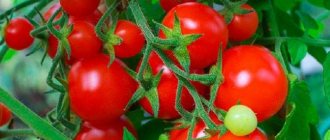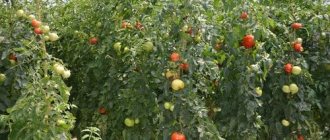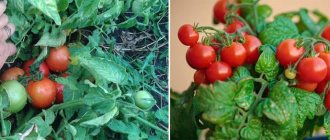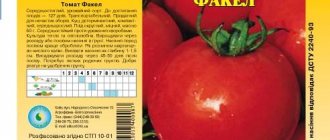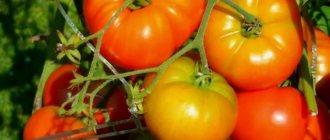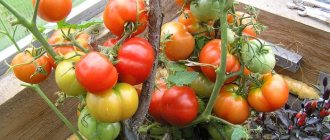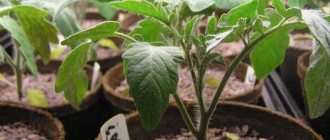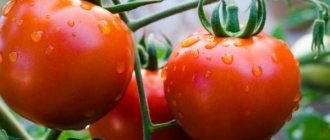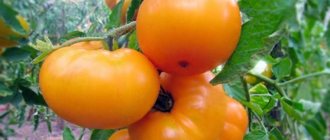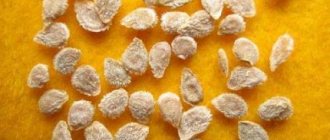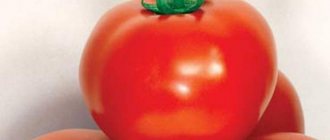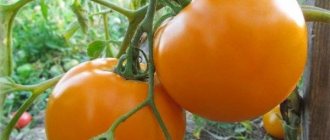Characteristics and description of the tomato variety Fleshy-sugary
The Fleshy-Sugar tomato was developed by Russian breeders in 2006 and immediately gained popularity in the market. Farmers and amateur gardeners liked it for its ease of care and high yield, and consumers liked it for its large (up to 700 g) sweet fruits with a thin skin.
Fleshy-sugary is a mid-season indeterminate variety, the first harvests of which can be obtained 90 - 100 days after planting the seeds. The bushes of the crop are compact, up to 1.5 m high. The shape of the tomatoes is round. Sometimes you come across slightly elongated specimens. The color is bright pink, closer to crimson, the surface is smooth, uniform, but may be slightly rough on emerging fruits. The pulp fully corresponds to the name of the variety: juicy, loose, soft. The tomato has 6 seed sections, each of which contains from 3 to 10 cream or beige seeds.
The variety is not leveled, so the first fruits reach a weight of 500 - 700 g, but subsequently it decreases to 250 - 300 g. The planting density is 4 - 5 bushes per 1 sq.m.
Technically ripe picked fruits can “get” the taste and sweetness at home: just put them in a warm, sunny place for a while
What is the variety
A detailed description of tomatoes will help a novice gardener to properly grow the plant and get the maximum yield from it.
- Bush: indeterminate (Aelita claims it is determinate).
- Height: 40–50 cm.
- Inflorescence: complex.
- Number of tomatoes in a brush: from 4 to 7 pcs.
- Ripening time: 95–105 days from the moment of emergence.
- Weight: 80–100 g.
- Shape: round.
- Color: red.
- Density: high.
- Taste: sweet, very juicy.
- Transportability: excellent.
- Shelf life: up to 2 months.
Rules for growing and care
If you want to get a large amount of a good harvest, then you need to follow the following recommendations when growing and caring for this variety:
It is best to grow this variety as seedlings. To do this, you need to plant the seeds in separate pots at the end of March or beginning of April. The soil where the seeds will be planted needs to be moistened. When the plants grow and have two leaves, they need to be planted in separate containers. Before planting plants in open soil, you need to thoroughly fertilize them up to three times
Important! In addition, you need to prepare plants for outdoor conditions in advance. To do this, sometimes it is worth taking pots of seedlings out into the open air so that the plant gets used to such conditions.
But you need to be careful and make sure that there is no frost outside, otherwise the plants will die. Seedlings can be transplanted into open soil when 60 days have passed after the seeds were planted; the optimal period for planting is the end of May - the beginning of June. If the seedlings are planted in a greenhouse, then the best time for transplanting is mid-April or early May. Important! At the same time, you need to monitor the weather and change the planting period if there is severe cold outside. Remove weeds in a timely manner, get rid of diseases and harmful insects, apply fertilizers, then the plants will grow healthy and delight you with tasty fruits. Watering should not be done too often, but abundantly. Important! The frequency of watering must be adjusted depending on weather conditions. If there is rain, the frequency of watering is reduced, as otherwise there is a risk of plant rotting.
Review: Aelita tomato seeds
28.03.2016
Advantages:
Easy to use, inexpensive, fast growing, early ripening variety.
Flaws:
No
We bought Sakhalin tomato seeds by accident. We wanted to plant Cherry tomatoes, but we couldn’t find them, but we found Sakhalin. The cost of a bag of seeds in Auchan was 9 rubles. The price is very reasonable. The packaging is beautiful. I liked the bunch of tomatoes on it. Production - Agrofirm AELITA. The manufacturer reports that this is an early ripening variety. On the back of the package it is written in detail about how and when to plant the seeds. Expiration date until December 2021. That is, theoretically, only part of the seeds can be planted. But we planted for the first time and planted all the seeds. Inside the package is a sealed bag of seeds. The seeds are large and there are many of them. Minimum 50 pieces per package. So we planted the seeds in mid-March, March 14, 2021 to be exact. The tomatoes were planted last - so we planted some of the seeds in a purchased mini-greenhouse, and some under film. The seeds were not treated before planting, they were not soaked in potassium permanganate, they were not poured with boiling water. They simply poured the seeds into a tray and covered them with earth. They poured water on it. We made a greenhouse and placed it under a radiator. The first seeds hatched on the 4th day. On the fifth day, the following picture could be seen: The sprouts shot up. Every day the number of seedlings increased. Below is a photo taken on March 20. March 26, 2016. The planting density was high. We never thought that so many tomatoes would sprout. In the end, we got about 60 shoots from one bag. The first real leaves are already appearing and we are looking forward to picking them up. I think the first experience of planting tomatoes was successful. The quality of the seeds deserves maximum praise. I recommend it. Now I know how to plant tomatoes.
I wish everyone a good harvest.
| Usage time: | 1 time |
| Price: | 9 rub. |
| Year of manufacture/purchase: | 2016 |
| General impression: | They sprouted quickly, grow quickly, and are inexpensive. |
| My mark: | |
| I recommend to friends: | DAGwhere is it more profitable to buy |
How to get an early harvest
The early maturity of the variety is its undeniable preference, but it is worth taking into account the climatic conditions of the growing region. Here, in turn, you can outsmart nature a little and speed up ripening by growing plants from seedlings.
There are many ways to germinate seeds early and obtain strong plants with well-developed root lobes; almost every summer resident has some personal secrets. For example:
- Seedlings do not tolerate heat, so the optimal temperature is +18 during the day and + 13 - 15 at night.
- A good level of lighting is required; on many cloudy days you will have to use a phytolamp.
- The humidity level is precisely regulated, abundant watering is carried out once a week, spraying from a distance is perfect 4-5 times a week.
- You should not sow seeds too early; you will end up with tall, anemic plants that will not tolerate transplantation well.
Need to consider:
A feature of the Sakhalin variety is the small number of stepsons, as a result of which the planting density reaches 4-5 plants per 1 sq. m. With proper care, the yield from this area reaches 6 kg.
When planting, the alternation of species must be taken into account; potatoes and tomatoes should be kept as far apart as possible, sharing beds with other types of plants. Since the Colorado potato beetle is observed crawling, the similarity of diseases is added to this and reducing them over such a large area is much more difficult than progressively treating two separate areas.
Seed culling before planting is carried out with a saline solution. Everything that appears on the surface after 15 minutes is disposed of. Treatment before planting is carried out with a solution of manganese, Fitosporin, aloe juice in half with water. A growth stimulator, for example, Vitrana-micro, Epina, accelerates germination. The timing for sowing seeds ranges from the 20th of March to mid-April.
The unpretentious and frost-resistant variety Sakhalin is perfect for canning in its entirety, preparing juice, tomato paste, sauces, transportation and long-term storage.
Description and characteristics of the variety
Kultivar was developed by Agro (Moscow). It was included in the register in 2008 and is recommended for cultivation in all regions. The Sakhalin tomato grows well in open ground and under film covers. It can be planted by summer residents and owners of personal plots.
In terms of ripening time, the variety is early ripening, the fruits ripen 90-95 days after emergence. The purpose is salad. The tomatoes are round, without ribs, red, medium-dense. Average weight 80 g, taste good.
The bush is tall, the main shoot grows until it is pinched. The inflorescence is branched, the leaves are of ordinary shape. The height of the main stem is 160-180 cm.
The fruits of the variety are suitable for canning, processing and preparing dishes from fresh vegetables.
Sakhalin - variety of tomato plant
Information on the admission of Tomato Sakhalin from the Register of the State Variety Commission of the Russian Federation
Application for admission No. 46816, registered 2006-12-14. The Tomato Sakhalin variety was included in the register of those approved in 2008. Approved for use in regions: All regions.
The originator of the Tomato Sakhalin variety is:
LLC `AGROFIRMA AELITA` (129343, MOSCOW, NANSEN TRADE, 1)
Information about the patent for the Tomato variety Sakhalin
Patent holder of the Sakhalin variety:
LLC `AGROFIRMA AELITA` (129343, MOSCOW, NANSEN TRADE, 1)
Application for protection of the Sakhalin variety No. 46817, registered 2006-12-14.
Patent No. 4008, registered 2008-05-20. Estimated patent expiration date 2038-12-31.
- Nastenko Natalya Viktorovna
- Kachainik Vladimir Georgievich
- Kandoba Alexey Viktorovich
Other varieties of tomato plant
Add new comment
Register or Login so you don't have to enter your Name and Email every time
Thanks for the comment! It will be published after checking by a moderator!
No comments yet, be the first!
A portal for those who love their dacha
Thanks for your question!
Your question has been sent for moderation. Don't worry, we quickly check your questions and your question will be answered within 1 day.
We have noticed that you are already registered on our website. We recommend that you log in to view the created question.
If you don't remember your password, you can recover it.
You were not registered until today, so we have registered you. Your password has been sent to your specified mailbox.
Help our site develop!
Please read this message, it will not take up much of your time!
We so need your comments and questions to understand in which direction we should develop.
Don't forget to leave a comment if you found what you were looking for. And if you haven’t found it, use the “Ask an Expert” form in the site header. We will answer this question, and other visitors will be able to find the information that you could not find.
Thanks for your question!
Your question has been sent for moderation. Don't worry, we quickly check your questions and your question will be answered within 1 day.
We have noticed that you are already registered on our website. We recommend that you log in to view the created question.
If you don't remember your password, you can recover it.
You were not registered until today, so we have registered you. Your password has been sent to your specified mailbox.
Sakhalin residents will be able to try six varieties of tomatoes | Soviet Sakhalin
The greenhouse complex is visible from afar. Built on the cut of a hill, it rises above the village of Kolkhoznoye as a symbol of its beginning prosperity.
Since the Nevelsky state farm died more than 20 years ago, life in Kolkhozny has come to a standstill; almost the entire working population goes to the city of Nevelsk to work.
When asked what the new greenhouse complex means for them, women who have already found work here answer in the same way as Alena Kuts: “These are jobs close to home, a decent salary.” And the village elder, head of the club Svetlana Nurmukhametova, looks further:
– The investor has already installed new lighting in Kolkhozny. We hope that a good road will appear in the village and new people will come here. Greenhouses are an impetus for further development of the village.
A huge greenhouse with an area of three hectares was built with private funds. The local investor is the Gornyak holding, headed by businessman Aslan Tadtaev. He conceived the construction of a new grandiose project just last year. They built the complex at an accelerated pace and completed it within a year, although the standard period for its construction is about 2.5 years.
According to experts, there is no more modern greenhouse in all of Russia than this one. The technical development and installation of all systems for growing plants using hydroponics was carried out by the famous Italian company.
It manufactures and sells greenhouses worldwide, as well as technologies for growing vegetables, berries, and flowers in protected soil. In the village of Kolkhoznoye, an Italian greenhouse was assembled under the guidance of Italian specialists.
The covering of the greenhouse is unique - not the usual glass, but a special two-layer film, which is inflated with air and, thanks to the air “cushion,” becomes more resistant to wind and snow loads. Smart automation controls the internal temperature.
On July 30, seedlings for future tomato plantations were already sown. Unusual and very tasty tomatoes will be grown in Kolkhozny: varieties “Rosario F1”, “Tachanka F1”, “Beef Tomato”, cluster “Merlise” of Dutch selection, “Pink Paradise F1”. The latter was recently developed in Japan and is in great demand due to its excellent taste, high yield, and glamorous appearance.
The chief agronomist of the greenhouse complex of Nevelsky AgroSnab LLC, Irina Tkachenko, says that they will still experiment with varieties. It is unknown how hybrids will behave in Sakhalin conditions. Perhaps, based on the results, one variety that has shown itself best will be taken into production.
The seedling department is completely sterile; no one outside is allowed there. While the seedlings are in mineral wool cubes, in September they will be transplanted into place, onto a block. And the harvest will begin in October - early November. The estimated yield is 45 kg per square meter.
What’s also unusual is that tomatoes in the greenhouse complex will be pollinated by... bumblebees. They will be brought all the way from the Voronezh region. One hectare requires five families of winged workers. For three hectares there are 15 flying “squads”. Families must be updated every two weeks.
The region does not train specialists to work in such modern greenhouses, so they were invited from the mainland. For hired professionals, five two-story, four-apartment houses are being built right at the entrance to the complex. The buildings are modern, beautiful, and will be heated from a greenhouse boiler house. Two of them are already fully ready to accept new residents.
As we can see, the construction customer thought about everything, even about housing for workers. By the way, all hired residents of Kolkhozny will be trained in new technologies.
The new greenhouse complex in the Nevelsky district is definitely a very important facility not only for this area, but also for the neighboring ones. Until now, only imported vegetables were sold here. Now fresh, locally produced tomatoes will be on sale all year round.
According to the law of the market, competition between producers always has a positive effect on product prices.
And it is possible that with the new greenhouse complex reaching industrial capacity, prices for vegetables from other Sakhalin agricultural producers will decrease. Natalya Kotlyarevskaya.
The best varieties of tomatoes for 2021: photos and descriptions
When choosing tomatoes for their plot, gardeners, first of all, rely on varietal or hybrid characteristics. Productivity is the most important criterion on which the quantity and quality of the harvest depends.
Sometimes it can be difficult to choose the right option from the rich variety of tomatoes for open ground and greenhouses. Then varieties are selected depending on the growing region, ripening period, degree of disease resistance and other factors.
A huge number of species with excellent yields are intended for growing vegetables in the open air. Low-growing bushes with large fruits are one of the advantages of tomatoes for the soil. Such heat-loving plants are easier to care for and do not require complex agricultural practices.
According to ripening period
Tomatoes, like other vegetable crops, are characterized by different ripening periods, from early to late.
| Ripening period | Ripening of fruits after the appearance of the first shoots | general characteristics | The most productive tomatoes (2020) |
| Ultra-early ripening | On day 80-85 | The fruits are small, juicy, and low in sugar. The height of the bush is no more than 50 cm. Not suitable for preservation. | Little Red Riding Hood, Pride of Russia, Benito, Superstar, Valentina, Marisha, Maksimka |
| Early ripening | For 90-95 days | Small, delicate fruits, average yield. Suitable for canning and salads. Bushes grow up to 70 cm | Agatha, Riddle, Augustine, Lyana, Sanka, Buyan, Lakomka, Amur standard, Grandmother's kiss |
| Mid-early | On days 100-103 | The fruits are juicy, small, aromatic. The purpose is universal. Bush shape - compact | Openwork, Babushkino, Pulka, Red Giant, Russian Soul, Cardinal, Flamingo |
| Mid-season | On day 100-115 | High taste, excellent yield. There are both low-growing and tall varieties | Scarlet Candles, Hybrid Basket, Stresa, Intuition, Black Baron, Pudovik, Pink Honey |
| Late ripening | On day 120-130 | Excellent fruit taste, high yield, universal purpose. Good keeping quality and transportability of fruits | Giraffe, Cosmonaut Volkov, Titan, Rio Grande, Russian size, King of Kings, Rocket, Premier |
The ripening time, color and shape of tomatoes depends on the variety.
Usually early-ripening vegetables with not large fruits and not a large harvest, but with a quick, friendly yield of ripe tomatoes. Mid-season ones also have medium sizes. Late ones are usually difficult to care for, but it is among them that you can find champions in weight, but there are not many such beauties on the bush.
Every year, breeders create new species with high quality indicators. In stores you can buy specialized varieties of tomatoes designed for growing in certain climatic conditions. Classification by regions of Russia:
- for the Moscow region: Champion, Sweet Bunch, Honey, Pink Elephant, Fireworks, Bull's forehead;
- for the southern regions: Torch, Novice, Titan, Winner, Bison, Ermak, Gift, Mikado;
- for the middle zone: Bull's Heart, Black Prince, Uzbek (Yusupov), Moskvichka, Snowdrop, Big Brother, Spasskaya Tower;
- for Siberia: Siberian heavyweight, Ultra early ripening, Sanka, Abakan pink;
- for the Urals: Coin, Bull's Heart, Button, Countryman, Yellow Buyan, Bullfinch, Demidov;
- for the far north: Snowy Tale, Ballerina, Ladyfingers, Berdsky Large, Countryman, Oak, Gina.
An unpredictable, cold or, conversely, excessively warm climate is not a reason to refuse to grow tomatoes in open ground. Thanks to selection, varieties have been developed that grow and develop well in any terrain.
To obtain a rich harvest, you need to choose tomato varieties not only with the appropriate characteristics. It is necessary that this criterion be supplemented by such an indicator as disease resistance.
Late blight, root rot, tobacco mosaic, cladosporiosis are diseases that most often affect plantings of heat-loving crops.
A catalog of tomatoes that can withstand the onslaught of various diseases:
- Blitz;
- Koenigsberg;
- Geisha;
- Betta,
- Anyuta;
- Bohemia;
- Chio-chio-san;
- Tatiana;
- Puzata hut;
- Lights of Moscow;
- Yablonka Russia;
- Crimson giant.
Unfortunately, there are no varieties that are 100% resistant to infections. But there are hybrids that produce a harvest until the active phase of many fungal diseases and infections begins.
Having a good greenhouse at your disposal, you can get fresh tomatoes to your table all year round. Greenhouse varieties are suitable for preparing salads or canning. Excellent salad tomatoes can be obtained from the following varieties:
- Geisha;
- Fairy gift;
- Andromeda;
- Eagle beak;
- Pink Angel;
- Pink Pearl;
- Fatalist;
- Scarlet caravel;
- Amana orange
We invite you to read: The benefits and harms of feijoa
The best varieties for preservation:
- Auria;
- Banana legs;
- Pink raisins;
- Rajah;
- Baba;
- Alexander the Great.
Cherries are sweet, small tomatoes that grow well both outdoors and in a greenhouse, but small-fruited vegetables tend to be more productive in protected beds. Magic Harp F1 and Yellow Caramel F1 are hybrids whose fruit weight does not exceed 25 g.
When choosing a vegetable for a greenhouse, many rightly give preference to tall and high-yielding varieties. But low-growing plants, which usually have an early ripening period, as well as mid-ripening tomatoes, are also excellent for polycarbonate shelters in all regions of Russia.
For open ground, breeders also offer species with high yields of hybrid origin; they are resistant to diseases and temperature changes. The best tomato varieties of 2020:
- Intuition F1 is one of the best tomato hybrids for picking with trusses, mid-season, from germination to harvesting the first vegetables - 110 days.
- Katya F1 is an early ripening hybrid. The fruits weigh 90-130 g and ripen simultaneously. From 1 m² you can harvest more than 10 kg of fruit per season.
- Search F1 – unpretentious and at the same time tasty tomatoes. The hybrid withstands cold weather and is immune to most diseases. The bushes are strewn with small red fruits, which are excellent for pickling and canning.
- Blagovest F1 is an early-ripening hybrid. The fruits are round, glossy, with slightly pronounced ribbing. From one bush you can collect up to 5 kg of fruit.
- La la fa F1 - has excellent consumer qualities, high yield and unpretentiousness. The average weight of the fruit is 140-170 g. From 1 m² you can harvest up to 20 kg.
- Vladimir F1 - has a high yield and is suitable for cultivation in any type of soil. High productivity throughout the entire fruiting period.
- Beef King F1 is an early maturing Dutch hybrid. The tomatoes are round, dense, smooth. From one bush you can collect up to 4-5 kg. Resistant to low temperatures and diseases.
- Ashdod F1 – tomatoes with smooth, dense skin. Fruit weight is from 110 to 140 g. The pulp has a bright burgundy color.
- Tanya F1 is a hybrid from the Netherlands with excellent immunity, dense structure, and good yield. The fruits have a regular round shape, weighing 150-200 g. They tolerate transportation well.
If the designation on a bag of planting material is F1 – hybrids of tomatoes (or other plants) of the first generation, F2 – of the second, and so on.
Exceptional taste, fruit weight, constant yield, disease resistance, adaptation to weather conditions are the advantages of hybrids over tomato varieties.
Reviews
My favorite tomato variety in 2021 is Idol, medium-sized, very tasty, productive. I planted seedlings on March 20, the first fruit was picked on June 20. The bushes bear fruit for 3 months. The most successful cherry variety is Black Cherry, very tasty and productive, the most favorite tomato of children.
I like the fruits to be large and regular in shape. Therefore, I prefer the varieties Early Rose, Peach, Heavyweight of Siberia and Pink Fig. This year I raised Grandma's Secret. The bush is determinate, the average height is 180 cm.
I never conduct systematic analysis. I analyze when the tomatoes are already picked. I love large, sugary berries. I really like the Pink Giant in taste, but the yield is low. So far, my requirements are relatively met by 2 varieties - Pink Andromeda and Mazarin. Over time (I’m a novice gardener) I’m thinking of finding the optimal variety or hybrid of tomatoes.
Now I mainly grow tomatoes in my dacha. About 20 different varieties. Red, yellow, brown, black. Beauty! Cherry, Cream, Ox heart. Different sizes, different tastes, different ripening periods - from May to October.
Stability of the harvest from year to year, the ability to adapt to weather conditions, resistance to pests and diseases are important criteria for a reliable tomato variety. In 2021, you can plant both time-tested tomatoes and new elite varieties. The choice depends only on the preferences of gardeners.
Features of growing the variety
The Giant Crimson tomato variety grows and bears fruit successfully in regions with a warm climate and a lot of sunny days, because this variety requires good lighting. Therefore, for cultivation in open ground, Giant is recommended in the following areas:
- Astrakhan;
- Belgorodskaya;
- Voronezh;
- Saratovskaya;
- in the Krasnodar region;
- in the republics of the Caucasus.
In more northern regions, it is better to grow raspberry Giant tomatoes in protected ground.
Sowing seedlings
Before seeds are sown in the ground, they should be prepared for planting:
- soak in a dark pink solution of potassium permanganate for 30-40 minutes;
- place the seeds in clean water for a day, change the water every 3-4 hours (so that the seeds do not suffocate);
- Before sowing, you can treat the seeds with some growth stimulant (for example, Zircon);
- dry the seeds on a paper napkin;
- Fill the seedling container with nutritious soil and compact it slightly;
- water the soil generously;
- spread lightly dried seeds over the surface of the soil at a distance of 2-2.5 cm;
then carefully sprinkle with slightly damp soil to a height of no more than 1.5 cm.
Place containers in plastic bags or cover with film. Once or twice a day, open the drawers slightly to ventilate and prevent the appearance of mold, moss, etc. Ventilate until shoots emerge.
Seeds should be sown 2.5-3 months before the intended planting of seedlings in the ground. In central Russia this is approximately the third ten days of February to the first ten days of March.
Characteristics of Sakhalin tomato and description of the variety
The early Sakhalin tomato captivates summer residents with its taste and harvest volumes, being both an unpretentious and versatile species.
What is the variety
A detailed description of tomatoes will help a novice gardener to properly grow the plant and get the maximum yield from it.
Plant:
- Bush: indeterminate (Aelita claims it is determinate).
- Height: 40–50 cm.
- Inflorescence: complex.
- Number of tomatoes in a brush: from 4 to 7 pcs.
- Ripening time: 95–105 days from the moment of emergence.
Fetus:
- Weight: 80–100 g.
- Shape: round.
- Color: red.
- Density: high.
- Taste: sweet, very juicy.
- Transportability: excellent.
- Shelf life: up to 2 months.
Care and planting
When planting tomatoes on their plots, summer residents choose a specific place. It should be sunny and, if possible, hidden from gusts of wind. It is best if cucumbers, carrots, cabbage or legumes grew in this place last year.
Seeds for seedlings are planted in March or early April, 2 months before planting in the ground. It all depends on the individual conditions of the region.
Picking is required. The plant must form a strong foundation. To do this, they are seated in separate containers.
It is best to prepare a tomato for transplanting in advance by hardening it off. This is done this way: the plant is taken outside for a while, gradually increasing the period of exposure to the sun.
After the tomatoes are planted in a permanent place, they should be watered, loosened and fertilized. To increase yields, the plant is formed into 1–2 trunks, and excess stepsons are removed. Tie up bushes as needed. Feed 2-3 times per season. Planting density is 3–4 plants per 1 m2 according to a 50 by 40 cm pattern.
Disease susceptibility
In general, the plant is resistant to major tomato diseases. The pathogens of verticillium, fusarium wilt and tobacco mosaic are not afraid of it.
Positive and negative aspects of the species
The characteristics of tomatoes, revealing the characteristics of the variety, help those who find it difficult to make a choice.
Pros:
Disease resistance. Unpretentiousness. Does not require a garter. Productivity. The fruits do not crack. Suitable for long-term transportation. The fruits of the variety have an excellent presentation, even after 1–1.5 months of storage.
The cons are unstable and minor.
Harvest volume and application
Fruits until late autumn. As a result, the yield is high. From one plant you can collect up to 3 kg of fruit.
https://youtube.com/watch?v=i4myhmwW8h5
The scope of tomatoes is wide. Suitable for:
- Whole canning.
- Making fresh salads.
- Culinary processing, preparation of juices, sauces and tomato paste.
Opinions of summer residents regarding Sakhalin tomatoes
Those who planted Sakhalin tomatoes on their plots leave reviews. They reveal all the necessary information about care, growing methods, and feeding.
- Tasha, Moscow. I purchased this tomato variety by accident. But once I planted it, I fell in love with it. I didn’t treat the seeds with anything, I planted them just like that, just watering them with water. One hundred percent germination rate. He writes the following: “I grow it in a greenhouse and greenhouse. The variety impressed with its characteristics and taste. We will definitely repeat the experience next year.”
- Hope. I bought tomatoes to try and planted them for the first year. Formed a plant into 1 trunk. After the formation of 5 brushes, I removed the growth point. Excellent tomatoes have grown. Everyone liked it. I tried canning it for the winter. If you like it, you will definitely plant it next year.
- Alexandra, Sakhalin region. The experience was unsuccessful, the tomatoes were not impressive. Or insufficient care or unsuitable soil. The plants were not shaped or fed. Perhaps they will try to plant tomatoes next year, in a different place and with proper care.
- Vladimir. I bought a package of tomato seeds as a gift for my wife. I have never regretted it. The whole family loved tomatoes. Used fresh in salads. They rolled up the jars for the winter. Excellent for making juices.
The unpretentious tomato variety "Sakhalin" is perfect for growing both in greenhouses and open ground. The high resistance to pathogens of tomatoes makes it irreplaceable.
Characteristics of the Astrakhan tomato
Astrakhan tomatoes reach the stage of technical ripeness (fully formed, but remain green) 4 months after the seedlings emerge. Therefore, harvests begin to be harvested closer to mid-July. Fruiting occurs at different rates, not in one wave. You can collect fruits until the end of August (weather permitting). Tomatoes are left to ripen on a branch or sent to ripen in a dark, moderately cool place.
Astrakhan tomato yield and fruiting
Astrakhan tomatoes are very productive (for determinate varieties). In good weather, subject to the rules of agricultural technology, you can harvest up to 3.5 kg of tomatoes from 1 bush.
| growing method | greenhouse | in the garden |
| from 1 bush, kg | 3-3,5 | 2,5-3 |
| from 1 m2, kg* | 21-24 | 17-21 |
*Since Astrakhan tomato bushes are compact, up to 7 plants can be planted per 1 m2.
To get a rich harvest, it is better to grow Astrakhan tomatoes in a greenhouse (especially in regions with short summers). In addition, experienced summer residents recommend following a few simple rules:
- Regular but moderate watering.
- Balanced feeding at least once every 2-3 weeks.
- Preventive treatment for diseases.
- Ventilation of the greenhouse.
- Although Astrakhan tomato bushes do not require pinching, it is better to periodically remove excess side shoots.
To save space, summer residents and farmers practice dense planting technology (the distance between Astrakhan tomato bushes is 20 cm). In this case, you need to make a very strong support - a structure of several sticks with stretched ropes (ordinary pegs will not work).
Area of application of fruits
These tomatoes are universal in purpose. They are good fresh and suitable for preparing all kinds of dishes and homemade preparations:
- soups;
- sauces;
- salads;
- second courses;
- tomato juice;
- lecho;
- whole-fruit canning (salting, pickling).
Resistance to diseases and pests
Judging by the reviews of summer residents, the immunity of Astrakhan tomatoes is very good - they rarely suffer from fungal diseases. However, late blight and tobacco mosaic can grow on the bushes. Therefore, treatment with fungicides is mandatory (for prevention, it is carried out at the end of May).
An insect invasion is also possible. In these cases, the bushes should be immediately sprayed with insecticides or proven solutions prepared according to folk recipes.
Tomato Sakhalin: variety description, characteristics
The Sakhalin tomato is one of the recently emerging tomato varieties, characterized by productivity and early ripening.
Description of Sakhalin tomatoes
Characteristics of tomatoes
According to the description, the Sakhalin tomato variety has a number of characteristics:
- refers to varieties with an early or middle fruiting period;
- has a sour taste;
- produces medium-sized round fruits;
- has a bush 50 cm high.
Tomatoes are grown in open ground and are suitable for cultivation in film and glass greenhouses. The fruits are suitable for all types of consumption, including fresh products such as salads or slices and preparations in the form of canning. Canning whole fruits is especially convenient because they are compact, round and relatively small.
The safety of the harvested crop is quite high. It reaches 2 months, thanks to the dense and elastic skin of the fruit.
In two months you can travel half the country, while supplying vitamin products to regions where growing tomatoes is considered a problem. This applies to the Far North and Siberia.
Description of the bush
Sakhalin is a determinate variety of tomatoes.
About 6 tassels are tied on the bush. It is compact, has both a raceme with ripening fruits and a raceme with flower buds, and needs a garter.
Description of fruits
Sakhalin begins to bear fruit 3 months after planting and until late autumn. Each cluster of the plant blooms at the same time, the fruits ripen at the same time, making it possible to harvest the entire bunch of tomatoes.
The fruits are red in color and do not have yellowness or green spots in the stalk area. The dense and elastic skin of vegetables protects the pulp from damage. The pulp itself has a dense structure, but at the same time meaty and very tasty.
The plant needs to be tied up
Growing
The variety is sown for seedlings in March. Before sowing, the seeds are treated with stimulants. These can be industrial preparations or homemade solutions. These include extracts from aloe juice or weak solutions of potassium permanganate.
The seeds are soaked in the evening and left until the morning, after which they are washed with clean water to remove any remaining stimulants and protect the seed material from chemical burns.
Trays or other containers with seed material are covered with film to create a greenhouse effect. A stable temperature of about 25°C is maintained inside. The soil is not watered, but sprayed with a sprayer. Heat, light and humidity are the components of the emergence of friendly shoots.
After 2 leaves appear, the seedlings are planted in a larger container. After rooting, fertilizers are applied. During growth (from 55 to 70 days), seedlings are fertilized at least 3 times. For this purpose, a complete complex fertilizer is used. A week before planting in a permanent place, Sakhalin tomato seedlings are hardened off.
Planting in the ground and care
Seedlings are planted in open ground when the last spring frosts have passed and the soil has warmed up sufficiently. This usually happens in early June. The distance between rows of plantings should be within 70 cm, between plants in rows - 30-40 cm.
Ash is placed in each hole, the soil is watered, and the seedling is planted. In the future, plants are watered exclusively at the roots, without irrigating the leaves. The water should be warm and soft, not containing heavy salts. As the tomatoes grow, they shoot up, tearing off the lower leaves, helping air circulation between the bushes. This protects the tomatoes from rot and spoilage.
When watering, fertilizers are added to the water to promote rapid growth and ripening of fruits. Water-soluble fertilizers are purchased in specialized stores.
It is important to observe the dosage: an excess of chemicals will not allow plants to develop normally and will cause diseases.
Yield varieties of TOMATOES: in seeds and in reality Super tomatoes from “Gardens of Russia” Low-growing (Determinant) tomatoes / Pinching / Bush formation / Sharing secrets.
Lens grade
The variety was developed relatively recently and immediately gained popularity for its early ripening and resistance to sudden temperature changes. We took low-growing plants as a basis, and the result was a bush about 50 cm high with a developed root system and a powerful trunk. The seedlings calmly endure strong spring winds, bending slightly to the ground, and quickly recover from frosts. The process of formation of stepchildren is weak, no garter is required. There are 4 - 7 ovaries in a complex inflorescence; the first fruits reach ripeness within 95 days from planting. Friendly fruiting occurs in late July and early August.
The fruits are red, with a pinkish tint, round, in a continuous flow from 80 to 100 g. They glow in a beautiful cluster through the dark green foliage and ripen almost simultaneously. The pulp is dense with a sweet and sour taste. The dense hymen ensures the preservation of the fruits for up to 2 months, if they are removed a drop before ripe, placed in boxes with lattice walls and placed in a cool, dark place with average humidity.
Growing
The variety is sown for seedlings in March. Before sowing, the seeds are treated with stimulants. These can be industrial preparations or homemade solutions. These include extracts from aloe juice or weak solutions of potassium permanganate.
The seeds are soaked in the evening and left until the morning, after which they are washed with clean water to remove any remaining stimulants and protect the seed material from chemical burns.
The treated seeds are placed on light soil mixed with rotted humus and ash. The seed layer is covered with soil up to 2 cm high.
Trays or other containers with seed material are covered with film to create a greenhouse effect. A stable temperature of about 25°C is maintained inside. The soil is not watered, but sprayed with a sprayer. Heat, light and humidity are the components of the emergence of friendly shoots.
After 2 leaves appear, the seedlings are planted in a larger container. After rooting, fertilizers are applied. During growth (from 55 to 70 days), seedlings are fertilized at least 3 times. For this purpose, a complete complex fertilizer is used. A week before planting in a permanent place, Sakhalin tomato seedlings are hardened off.
The nuances of sowing and caring for (mushroom) plants
Seedlings of the Superstar variety should be sown after the 15th day. You need to pick the plant after three true leaves appear. After about two months, the young plants that grew at home are time to move to the greenhouse. Seedlings that are planted in protected soil in the second half of May usually produce a fertile harvest within one and a half months from the moment of planting.
After moving the plant for a permanent period of further growth, it is necessary to care for it: regularly water, loosen the soil, remove weeds and feed
It is also important to tie up the bushes so that the heavy weight of the tomatoes cannot break them.
Early ripe tomato Sakhalin - secrets of cultivation, detailed description, nuances of agricultural technology
Breeders delight gardeners by developing new varieties of tomatoes with excellent parameters. Among them are Sakhalin tomatoes, which combine early ripening, good yield, and resistance to many lesions. A detailed description of the universal variety will allow summer residents to successfully grow an early ripening crop. Pleasant shades of sweet and sour taste of tomatoes in various dishes will delight gourmets.
Description – brief description
An early ripening variety of tomatoes, bred agro, included in the State Register in 2008. It demonstrates excellent productivity in open ground, in greenhouses (under glass or film cover). Main characteristics of tomatoes:
- forms low bushes (40-50 cm);
- forms clusters with 4-7 fruits;
- tomatoes reach ripeness at 95-105 days;
- beautiful round fruits of a red hue;
- pleasant sweet and sour pulp of tomatoes;
- elastic skin, not subject to cracking.
The fruits are characterized by high preservation. This allows you to transport tomatoes over long distances without losing their presentation. If placed in a cool place, in boxes with access to air, tomatoes are perfectly preserved for up to 2 months.
Attention! Tomatoes of the Sakhalin variety are suitable for canning and preparing various dishes, and are incredibly tasty as salad components
| Early ripe, ripens at 95-105 days | Determinant (40-50 cm) | Universal | In open ground, in greenhouses | 80-100 | 8 kg in a greenhouse, 6 kg in open ground | Round, bright red, fleshy, with dense skin |
Advantages and disadvantages
Colorful photos of ripe Sakhalin tomatoes grown by amateur gardeners demonstrate the beauty of the bright fruits. Culture captivates with many advantages, among them:
- precocity;
- unpretentiousness;
- good yield;
- compact bushes do not require tying;
- resistance to diseases (tobacco mosaic, fusarium);
- tolerate lack of light and low temperature;
- excellent transportability.
The disadvantages of Sakhalin tomatoes include small fruit. In this regard, the variety is inferior to large-sized hybrids.
Features of agricultural technology
To plant early tomatoes, it is advisable to choose a sunny place, protected from gusts of wind. The best option is beds where carrots, cucumbers or various legumes grew.
Overview of agrotechnical actions:
- Grown by seedlings. The seeds are treated with a special solution.
- Planting begins in March/April (depending on the region). Seeds are planted to a depth of 2 cm.
- A prerequisite for growing is picking.
- Planted in prepared soil on day 55.
- The growth point is pinched at the stage of formation of the 5th brush.
- Planting density – 2-3 plants per 1 m², following a pattern of 50 cm by 40.
Attention! Planting in uncovered soil requires preliminary hardening. Young tomato bushes are taken outside, gradually increasing the time spent in the air
The nuances of growing the variety:
- The culture loves nutritious soil rich in organic matter.
- Seedlings must be watered on time and fertilized with complex fertilizers (2-3 times per season).
- When growing in greenhouses, the beds should be periodically ventilated, which will prevent possible damage by pests.
The variety is relatively new, but many gardeners have tried it on their plots. Summer residents note the unpretentiousness of tomatoes, resistance to coolness, and fruiting until late autumn.
- According to Margarita from the Stavropol Territory: “The variety pleased me with a bountiful harvest. The beautiful, neat fruits looked beautiful when preserved. Their skin remained intact and did not crack.”
- According to Zinaida from the Lipetsk region: “The Sakhalin tomato seeds conquered with excellent germination - almost all of them hatched. I grew it in unprotected soil in my garden. The juicy, sweetish fruits were enjoyed by everyone in the household.”
- According to Irina from the Moscow region: “I purchased Sakhalin seeds from Aelita on the advice of a friend. The result was impressive. We managed to grow a good crop in the greenhouse. I made juices, pastes, adjika from the fruits, and used them fresh in salads.”
Growing Sakhalin tomatoes bred by the Aelita agricultural company will be a successful experience in obtaining a good harvest of tomatoes, pleasing with taste, unpretentiousness, and early ripening.
Lens grade
The variety was developed relatively recently and immediately gained popularity for its early ripening and resistance to sudden temperature changes. We took low-growing plants as a basis, and the result was a bush about 50 cm high with a developed root system and a powerful trunk. The seedlings calmly endure strong spring winds, bending slightly to the ground, and quickly recover from frosts. The process of formation of stepchildren is weak, no garter is required. There are 4 - 7 ovaries in a complex inflorescence; the first fruits reach ripeness within 95 days from planting. Friendly fruiting occurs in late July and early August.
The fruits are red, with a pinkish tint, round, in a continuous flow from 80 to 100 g. They glow in a beautiful cluster through the dark green foliage and ripen almost simultaneously. The pulp is dense with a sweet and sour taste. The dense hymen ensures the preservation of the fruits for up to 2 months, if they are removed a drop before ripe, placed in boxes with lattice walls and placed in a cool, dark place with average humidity.
Growing
The fleshy-sugar tomato is quite unpretentious to grow. The plant withstands direct sunlight and, conversely, lack of light, drought and abundant watering. However, for full fruiting, the crop urgently needs warmth. The amount of harvest that can be harvested depends on proper cultivation. Most of the properties of the future bush are established during the growing of seedlings. Correct and timely planting, adequate fertilizing and suitable climatic conditions are the key to a good harvest.
Growing seedlings
To get a healthy plant, you should first take care of the seedlings. Growing Fleshy-Sugar tomato seedlings is not a troublesome task. Experienced gardeners claim that this variety has good germination. Seeds of ripened tomatoes can be used for replanting next year, but breeders recommend renewing them at least once every three years, otherwise the fruits will become smaller and lose some of their sweetness.
Landing rules
Sowing of seeds should be planned 40 - 45 days before moving into the soil. This means that the most favorable time is mid-March. Since the variety is not frost-resistant, it is advisable to focus on your own region: in the south you can start sowing seeds a little earlier, in the north - later.
For seedlings, it is recommended to use large, shallow boxes. Soil should be placed in them: a mixture of sand, peat, black soil and compost, and grooves should be formed. Before planting in the soil, seeds must be kept in water or a solution that stimulates plant growth for several hours.
Once removed from the liquid, the seeds can be immediately placed in the soil, then sprinkled with a centimeter layer of soil, sprayed with a spray bottle and covered with cling film. Future seedlings should be placed in a warm place. Irrigation is recommended to be carried out daily, at approximately the same time.
After the third leaf appears, the plants should be planted in small individual containers. 2 - 3 weeks before planting in open or closed ground, future tomatoes should begin to be hardened - taken out to the balcony or left in an open window for 10 - 15 minutes.
Already on the 5th – 7th day of cultivation you can see the first shoots. The time should be chosen so that at the beginning of July the plant is ready for planting.
Watering and fertilizing
As mentioned above, the Fleshy-Sugar tomato does not need frequent or abundant watering. A day before planting plants in a greenhouse or beds, they should be fed with mineral fertilizers. In the future, it will be possible to use fertilizing (potassium, phosphate and phosphorus) no more than once a week.
At average temperatures of +27 - 29 °C, you can water the bushes 2 - 3 times a week. When the air warms up above 30 °C, the number of irrigations can be increased to 5 - 6.
Pinching and tying
When cultivating Fleshy-Sugary tomatoes, the first two stepsons will have to be removed: they are non-fruit-bearing. In the future, such branches will take away useful substances from the main plant, reducing the yield.
The bushes of this variety are quite tall and spreading, so they can be significantly deformed when fruit is poured. A garter is necessary immediately after planting in the ground. At the initial stage, it is enough to tie the plant to small pegs. Over time, they will have to be replaced with higher and stronger supports.
Formation
The plant does not require formation. After the appearance of the first two non-viable shoots, the Fleshy-Sugar tomato no longer produces stepsons.
Protection from diseases and pests
This variety is susceptible to fungus and pests. After planting in the soil, you need to take care of mulching - sprinkle the ground with straw or wood shavings. Such troubles as phomosis and late blight can be dealt with by the drugs Hom, Consento and Tattu. Against the invasion of insects - slugs, mole crickets and moths - you can use the Gnome product.
Description of the Sakhalin tomato: growing features, planting and care
Until recently, gardeners had no problems choosing a tomato variety, because they had to be content with the availability of available seed. Twenty years ago the range of tomatoes was small.
Now so many varietal and hybrid varieties of this crop have been bred that it is difficult to choose the right ones from such a variety. The seed packages depict luxurious bushes with bunches of beautiful tomatoes. The description promises a rich harvest and excellent taste.
However, the qualities of certain tomato varieties declared by seed producers do not always correspond to reality. This is explained by the incorrectness of their choice for a given region with certain climatic conditions, the method of cultivation (greenhouse or open ground), and the applied agrotechnical conditions for growing tomatoes.
Before choosing seeds of suitable varieties, you need to decide on several factors:
- Local climate. The reason that good high-yielding varieties bear little fruit may be their inadequacy for a given region. Thus, Siberian types of tomatoes, which are distinguished by their tolerance to unfavorable temperature conditions, diseases, and pests, can produce full harvests in any climatic conditions. But southern varieties will bear little fruit in cold areas, even in greenhouses; some will not grow at all. The high yield indicators declared by sellers correspond to reality only in those regions where plants have a long growing season, when several harvests can be harvested from one bush.
- Where will the tomatoes grow - in a greenhouse or open ground. This question is very important. There are few universal varieties of tomatoes that can bear fruit equally well in stationary greenhouses and in the fresh air. Most species of these plants are adapted only to certain conditions. Therefore, you need to be especially careful when choosing seeds based on these indicators.
- The purpose of cultivation is for salads, canning or for sale. If you prefer to provide your diet with fresh tomatoes during the season, which are distinguished by their excellent taste and nutrient content, choose salad varieties. But such tomatoes are not stored for a long time and are not suitable for preservation. For preparations for the winter, it is better to choose special ones, which are medium and small in size, denser pulp, and strong peel. The taste and percentage of nutrients are noticeably lower than that of salad vegetables. There are even fewer of them in varieties for commercial cultivation - they are characterized by a long shelf life, high yield, in which their properties are reduced due to the number of fruits.
- Bush shape - low-growing (determinant) or tall (indeterminate) varieties. Tomatoes whose bush height is 50-70 cm are considered determinant. They are also found lower. Their cultivation is suitable for “lazy” and novice gardeners. Because such plants do not require much hassle with pruning and tying, some of them do not need to be tied at all. Indeterminate varieties are convenient to grow in small areas, but they require careful care for the formation of bushes, regular correct pinching, and for them you need to create special supports for garter. They grow up to 1.5 m or more.
- When is the harvest planned? To provide your summer diet with fresh tomatoes, choose early salad varieties. For harvesting, medium and late varieties are planted. In total, experienced gardeners grow several types of tomatoes on their plots, so as not only to receive fresh vegetables for the table all season, but also to insure themselves if any of them turns out to be low-yielding.
Having a good greenhouse at your disposal, you can get fresh tomatoes to your table all year round.
To do this, several varieties are planted with different ripening periods.
READ MORE: Tomato Voyage F1 - variety description, yield, photos and reviews from gardeners
Salad varieties
Features of agricultural technology
Considering the “Sugar Nastasya” tomato, the characteristics and description of the variety indicate that the tomato is large-fruited, tall and productive. In order for the variety to show all its inclinations and reveal its potential, careful preparation of seedling material and the fertility of the planting site is necessary.
Seedling period
For tall tomatoes, the main thing in seedlings is to grow a powerful, strong root system. The larger the nutrient absorption area, the more vigorously the tomato will increase its vegetative mass, set fruit and produce yield.
Taking into account this feature during the seedling period, it is necessary:
- timely sowing (so that the age of the seedlings when transplanted into the greenhouse is 55-60 days);
- timely picking of seedlings (in the phase of 2 true leaves);
- diving into an individual container with a volume of at least 500 ml;
- transplantation into soil with high nutritional value.
Planting in a greenhouse
When transplanting seedlings, it is necessary to carefully prepare the soil for planting seedlings. To do this, the soil is removed and enriched using:
- fresh humus of animal origin 1/3 bucket;
- mature compost - 1/3 bucket;
- soil removed for enrichment - 1/3 of a bucket;
- coarse sand - 1 kg per bucket of mixture;
- superphosphate - 2 tbsp. l per bucket of mixture;
- ammonium nitrate - 2 tbsp. spoons into a bucket of mixture;
- potassium sulfate - 1 tbsp. spoon onto a bucket of mixture;
- stove ash - 0.5 liters per bucket of mixture.
Planting is carried out carefully, without destroying the earthen ball. Having lowered the root system into the hole, it is covered with a pre-prepared nutrient soil mixture and watered abundantly until it is completely wet.
Formation
The tomato is tall and genetically predisposed to producing large fruit.
Therefore, formation should be carried out in only one shoot. As soon as stepsons begin to form, they are cut off or broken off, leaving a stump 2-3 mm high.
Stepchildren should not be allowed to outgrow; they absorb nutrients to the detriment of fruiting.
As soon as the seedlings are planted, you immediately need to worry about tying up the shoot. Each inflorescence of “Sugar Nastasya” bears 4-5 fruits weighing 300 g. The slightest curvature in the future, when a large mass of fruit formations is collected, can lead to breakage and loss of the harvest.
Feeding
Given the large removal of nutrients, they need to be replenished regularly.
- The first feeding is carried out with nitrogenous compounds 2-3 weeks after transplantation to a permanent place. To do this, dissolve 2 tbsp in a bucket of water. spoons of urea and add 0.5 liters to each bush after thorough deep watering;
- It is better to carry out the second feeding with organic fertilizers 2-3 weeks after the first. To do this, dissolve 1 kg of cow, horse or pig manure in a bucket of water and pour 0.5 liters under each bush;
- After 2-3 weeks, fertilizing is carried out by adding 2 tablespoons of superphosphate or potassium sulfate to a bucket of water.
Compliance with tomato cultivation techniques will help you get an excellent harvest of a wonderful tomato.
Tomato asset Sakhalin
It managed to combine:
- haste;
- high resistance to gray and apical rot, mosaic, late blight;
- resistance to the vagaries of nature;
- good transportability;
- unpretentiousness to the composition and quality of the soil.
Attention: lack of calcium and (too) much nitrogen lead to the development of diseases that affect the fruits and leaves. The variety has high resistance to the most common diseases; however, growing conditions must be observed, fertilizers must be paid in a timely manner and in the correct quantities, and preventive inspection of plants and their treatment at the first signs of the appearance of spots on leaves and fruits must be carried out.
